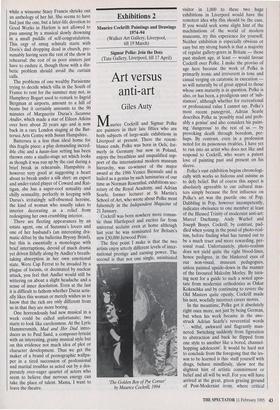Exhibitions 2
Maurice Cockrill: Paintings and Drawings 1974-94 (Walker Art Gallery, Liverpool, till 19 March)
Sigmar Polke: Join the Dots (Tate Gallery, Liverpool, till 17 April)
Art versus anti-art
Giles Auty
Maurice Cockrill and Sigmar Polke are painters in their late fifties who are both subjects of large-scale exhibitions in Liverpool at present. There the resem- blance ends. Polke was born in Oels, for- merly in Germany but now in Poland, enjoys the breathless and unqualified sup- port of the international modern museum hierarchy, was co-winner of the major award at the 1986 Venice Biennale and is hailed as a genius by such luminaries of our time as Norman Rosenthal, exhibitions sec- retary of the Royal Academy, and Adrian Searle, former lecturer at St Martin's School of Art, who wrote about Polke most fulsomely in the Independent Magazine of 21 January. Cockrill was born nowhere more roman- tic than Hartlepool and excites far from universal acclaim even at home although last year he was nominated for Britain's new £30,000 Jerwood Prize. The first point I make is that the two artists enjoy utterly different levels of inter- national prestige and earning power. The second is that not one single, uninitiated `The Golden Boy of Pye Corner' by Maurice Cockrill, 1994
visitor in 1,000 to these two huge exhibitions in Liverpool would have the remotest idea why this should be the case. If you would seek some slight hint of the machinations of the world of modern museums, try this experience for yourself. Neither exhibition is especially obvious or easy but my strong hunch is that a majority of regular gallery-goers in Britain — those past student age, at least — would favour Cockrill over Polke. I make the proviso of age here because the work of Polke is primarily ironic and irreverent in tone and casual verging on catatonic in execution so will naturally be of great appeal to those whose own maturity is in question. Polke is also, or has been, a prodigious user of 'sub- stances', although whether for recreational or professional value I cannot say. Polke's most recent panegyrist, Adrian Searle describes Polke as 'possibly mad and prob- ably a genius' and also considers his paint- ing 'dangerous' to the rest of us — by provoking death through boredom, per- haps. By contrast, even in a profession noted for its poisonous rivalries, I have yet to run into an artist who does not like and respond to Cockrill, who wears a patent love of painting past and present on his sleeve.
Polke's vast exhibition begins chronologi- cally with works so hideous and asinine as to defy belief. But of course this aspect is absolutely agreeable to our cultural mas- ters simply because the first influence on Polke's art was the puerile one of Pop. Dabbling in Pop, however incompetently, indicates obeisance to one member at least of the Blessed Trinity of modernist anti-art: Marcel Duchamp, Andy Warhol and Joseph Beuys. Cockrill, by contrast, pad- dled when young in the pond of photo-real- ism, before finding what has turned out to be a much truer and more rewarding, per- sonal road. Unfortunately, photo-realism does not yield quite the right blood-lines, hence pedigree, in the blinkered eyes of our non-visual, museum pedagogues, unless painted upside-down in the manner of the favoured Malcolm Morley. By turn- ing next for a guide to such a noted apos- tate from modernist orthodoxies as Oskar Kokeschka and by continuing to revere the Old Masters quite openly, Cockrill made his next, woefully incorrect career moves.
In the meantime, Polke got it absolutely right once more, not just by being German, but when his work became in the awe- struck Adrian Searle's reverential words `. . . wilful, awkward and flagrantly man- nered. Switching suddenly from figuration to abstraction and back he flipped from one style to another like a bored, channel- hopping adolescent'. It would be hard not to conclude from the foregoing that the les- son to be learned is this: stuff yourself with drugs, behave mindlessly, show not the slightest hint of artistic commitment or belief and all will be well. For you will have arrived at the great, green grazing ground of Post-Modernist irony, where critical carnivores cannot catch you and false moves become impossible to make. Figures as famous as Norman Rosenthal will dis- cern that your crass-looking creations are `full of double and triple meanings' although I do not think the average viewer will even care.
The Polke exhibition has been staged most lavishly at the Tate Gallery, Liver- pool, where it appears to me to be playing to an average audience of three. Good- hearted souls who favour an unlimited extension to the Tate Gallery's present powers and premises, whether in London or the provinces, might ask themselves what these may really bring us. Will we wit- ness yet more unquestioning obeisance to international fads and fashions?
Today, it is often our less vaunted gal- leries and museums, to say nothing of our enterprising commercial dealers, which reveal to us the artistic variety and inde- pendence of spirit essential for our cultural health. Who in Britain, instead of inflicting on us the mindlessness of Polke and others or the limp vapidity of such as Robert Gober, will now show international painters of the demonstrable stature of the Spaniard Antonio Lopez Garcia or the Australian William Robinson? And who else, like the Walker Art Gallery, will expose the best of our own, domestic mid- dle-generation painters to audiences up and down the country? Cockrill maintains the central British tradition of Romanti- cism honourably but there are others of similar worth. Here are questions which need not just asking but answering.



























































 Previous page
Previous page